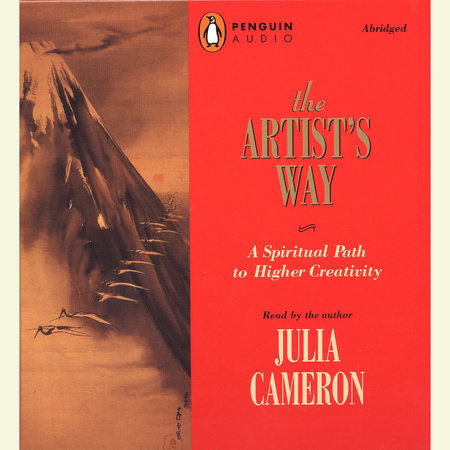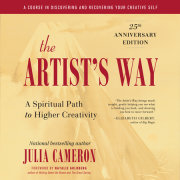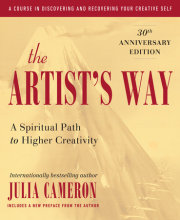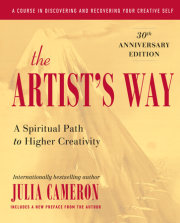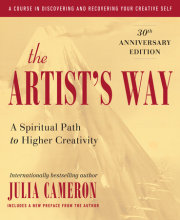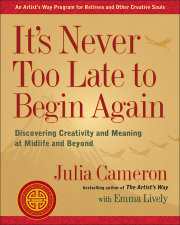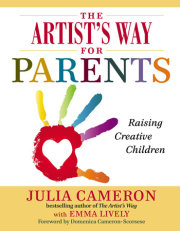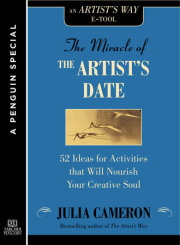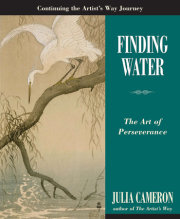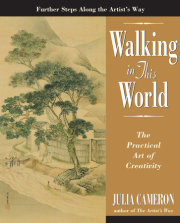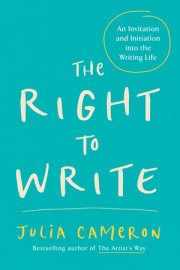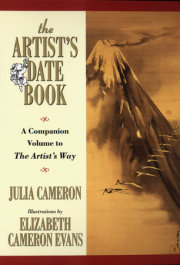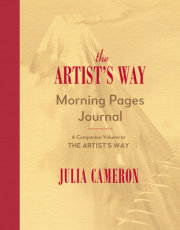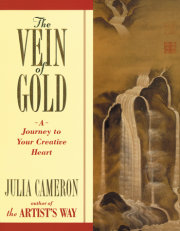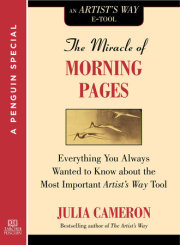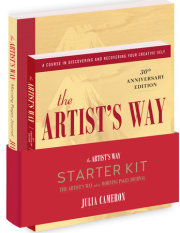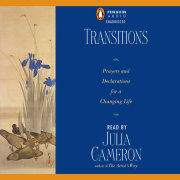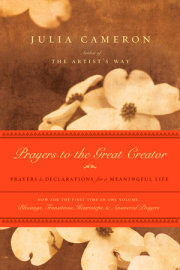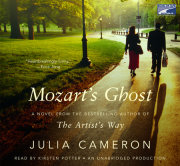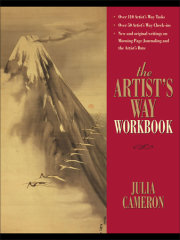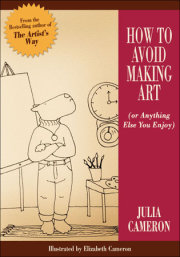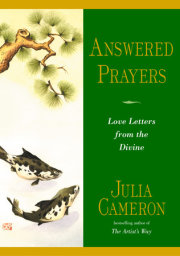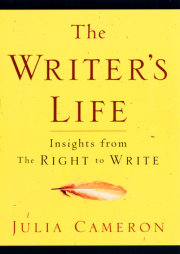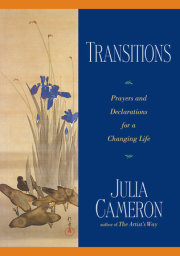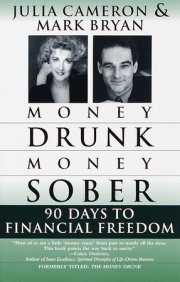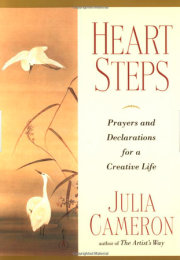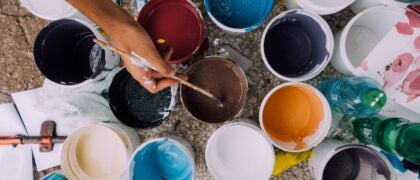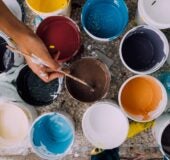ALSO BY JULIA CAMERON
NONFICTION
The Artist’s Way
The Artist’s Way Morning Pages Journal
The Artist’s Date Book (illustrated by Elizabeth Cameron)
The Vein of Gold
The Right to Write
God Is No Laughing Matter
Supplies: A Troubleshooting Guide for Creative Difficulties
(illustrated by Elizabeth Cameron)
God Is Dog Spelled Backwards
(illustrated by Elizabeth Cameron)
Heart Steps
Blessings
Transitions
Inspirations: Meditations from The Artist’s Way
The Writer’s Life: Insights from The Rightto Write
The Artist’s Way at Work (withMark Bryan and Catherine Allen)
Money Drunk, Money Sober (with Mark Bryan)
FICTION
Popcorn: Hollywood Stories
The Dark Room
PLAYS
Public Lives
The Animal in the Trees
Four Roses
Love in the DMZ
Avalon (a musical)
Bloodlines
The Medium at Large (a musical)
Tinseltown (a musical)
Normal, Nebraska (a musical)
POETRY
Prayers for the Little Ones
Prayers for the Nature Spirits
The Quiet Animal
This Earth (also an album with Tim Wheater)
FEATURE FILM
(as writer-director)
God’s Will
Most Tarcher/Putnam books are available at special quantity
discounts for bulk purchases for sales promotions, premiums,
fund-raising, and educational needs. Special books or book
excerpts also can be created to fit specific needs.
For details, write Putnam Special Markets,
375 Hudson Street, New York, NY 10014
Jeremy P. Tarcher/Putnam
a member of
Penguin Putnam Inc.
375 Hudson Street
New York, NY 10014
www.penguinputnam.com
Copyright © 1992, 2002 by Julia Cameron The Artist’s Way is a registered trademark of Julia Cameron.
All rights reserved. This book, or parts thereof, may not be reproduced in any form without permission. Published simultaneously in Canada
Library of Congress Cataloging-in-Publication Data
Cameron, Julia.
The artist’s way : a spiritual path to higher creativity / Julia Cameron. p. cm.
ISBN: 9781101156889
I. Creative ability—Problems, exercises, etc. 2. Self-actualization (Psychology)—Problems, exercises, etc. 3. Creation (Literary, artistic, etc.) I. Title.
BF408.C175 1992
153.3’5—dc20 92—5906
CIP
This book is printed on acid-free paper.
MY ARTIST’ S WAY GRATITUDE LIST
AT THIS POINT, WELL over a million people have contributed to The Artist’s Way. It is truly a movement. There are, however, people without whom its safety and growth could not have occurred. I wish to thank some of them here.
Jeremy Tarcher, for publishing my work, editing and caring for it so carefully with his characteristic brilliance and vision.
Joel Fotinos, for nurturing and guarding my body of work—husbanding not only my work but my deepest heart and truest dreams with clarity and strength.
Mark Bryan, my gratitude for fighting to protect and defend my body of work, for his innovative and visionary thinking and capacity to understand and forgive our frequently—and necessarily—divergent paths.
My daughter, Domenica Cameron-Scorsese, for sharing her mother and bearing the dual pressures of second-generation fame and first-rate talent. My gratitude for being always the kind of artist and person for whom I want to write good and useful books. With admiration for her shrewdness, tenderness, and sheer creative “guts.”
Emma Lively, with gratitude for her visionary strength and her bold and daring conviction in her work both with my music and my books. A true friend, not only to my creativity but also to my dreams and desires. We met through The Artist’s Way and my musical Avalon, and have enjoyed combining our Artist’s Ways as musical collaborators over the last four years.
Susan Schulman, with gratitude for her long years of devotion and commitment to The Artist’s Way, with admiration for her vision and with humility for her courage throughout our parallel and difficult trials.
With gratitude to Pat Black and company, for holding a steady course as The Artist’s Way, and I myself, grew in fits and starts.
With gratitude to David Groff, for his fine writing and thinking.
To Johanna Tani, for her graceful and acute editing.
And to Sara Carder, for her deft and careful assistance above and beyond the call of duty—all three of these creative souls.
James Nave, for his loyalty and generosity as a long-term teaching partner.
And to Tim Wheater, a special thank-you for his musical brilliance and creative and teaching partnering through multiple years and projects.
Gratitude also to Mauna Eichner and Claire Vaccaro, for their inspired and fastidious design work, remembering always that form follows function—to make my books embody that artist’s formula—“Beauty is truth, and truth is beauty.”
Gratitude always, too, to my sister and frequent collaborator, fine artist and cartoonist Libby Cameron, whose wit and whimsy allowed me to create additional tools to support The Artist’s Way. She well knows the truth that laughter is the best medicine, and helped me in administering creative first aid with a spoonful of sugar to make the medicine go down. My deepest thanks for her inspired work on The Artist’s Date Book, Supplies, God Is Dog Spelled Backwards, and the upcoming How Not to Make Art—or anything else that really matters.
My gratitude to Sonia Choquette and Larry Lonergan, for their love and clarity of vision as I labored to bring into fruition large dreams from small seeds.
To Edmund Towle and Robert McDonald, for their creativity and chivalry as they both protected and inspired me to do all forms of my creative work.
Finally, I wish to thank those who have gone before me and shown me the path, most especially Julianna McCarthy, Max Showalter, John Newland, and all who hold a spiritual lantern to light our Artist’s Way with their artistry and generosity.
THIS SOURCEBOOK IS DEDICATED to Mark Bryan. Mark urged me to write it, helped shape it, and co-taught it. Without him it would not exist.
Table of Contents
Title Page
Copyright Page
Dedication
Introduction
WEEK 1 - Recovering a Sense of Safety
WEEK 2 - Recovering a Sense of Identity
WEEK 3 - Recovering a Sense of Power
WEEK 4 - Recovering a Sense of Integrity
WEEK 5 - Recovering a Sense of Possibility
WEEK 6 - Recovering a Sense of Abundance
WEEK 7 - Recovering a Sense of Connection
WEEK 8 - Recovering a Sense of Strength
WEEK 9 - Recovering a Sense of Compassion
WEEK 10 - Recovering a Sense of Self-Protection
WEEK 11 - Recovering a Sense of Autonomy
WEEK 12 - Recovering a Sense of Faith
EPILOGUE
The Artist’s Way Questions and Answers
Creative Clusters Guide
APPENDIX: TRAIL MIX
READING LIST
INDEX
About the Author
Excerpt from The Prosperous Heart
INTRODUCTION TO THE TENTH ANNIVERSARY EDITION OF THE ARTIST’S WAY
ART IS A SPIRITUAL transaction.
Artists are visionaries. We routinely practice a form of faith, seeing clearly and moving toward a creative goal that shimmers in the distance—often visible to us, but invisible to those around us. Difficult as it is to remember, it is our work that creates the market, not the market that creates our work. Art is an act of faith, and we practice practicing it. Sometimes we are called on pilgrimages on its behalf and, like many pilgrims, we doubt the call even as we answer it. But answer we do.
I am writing on a black lacquer Chinese desk that looks west across the Hudson River to America. I am on the far western shore of Manhattan, which is a country unto itself, and the one I am living in right now, working to cantilever musicals from page to stage. Manhattan is where the singers are. Not to mention Broadway. I am here because “art” brought me here. Obedient, I came.
Per capita, Manhattan may have a higher density of artists than anywhere else in America. In my Upper West Side neighborhood, cellos are as frequent and as ungainly as cows in Iowa. They are part of the landscape here. Writing at a typewriter, looking out across the lights, I too am something Manhattan knows very well. I write melody on a piano ten blocks from where Richard Rodgers, a gangly adolescent, climbed a short stoop to meet a short boy who became his longtime partner, Larry Hart. Together they dreamed through drought and flood.
My apartment is on Riverside Drive. At this narrow end of the island, Broadway is a scant block behind my back as I face west across the river, inky black now as the sun sets in colored ribbons above it. It is a wide river, not only dark, and on a windy day—and there are many—the water is choppy and white-capped. Cherry-red tugboats, as determined as beetles, push their prows into the waves, digging their way up and down the river, pushing long barges with their snouts. Manhattan is a seaport—and a landing for dreams.
Manhattan teems with dreamers. All artists dream, and we arrive here carrying those dreams. Not all of us are dressed in black, still smoking cigarettes and drinking hard liquor, still living out the tawdry romance of hard knocks in tiny walk-up flats filled with hope and roaches in neighborhoods so bad that the rats have moved on. No, just like the roaches, the artists are everywhere here, tenements to penthouses—my own building has not only me with my piano and typewriter but also an opera singer who trills in the inner canyons like a lark ascending. The neighborhood waiters are often—not always—actors, and the particularly pretty duck-footed neighborhood girls do dance, although you wouldn’t imagine their grace from their web-footed walks.
I drank a cup of tea at Edgar’s Cafe this afternoon, the cafe named for Edgar Allan Poe, who lived down here and died farther uptown, all the way in the Bronx. I’ve looked up into Leonard Bernstein’s ground-floor windows at the Dakota, and gone a little numb each time I pass the arched entryway where John Lennon was shot. In this apartment, I am a scant block from Duke Ellington’s haunts, and there’s a street named after him too. Manhattan is a town full of ghosts. Creative power—and powers—course through its vertical canyons.
It was in Manhattan that I first began teaching the Artist’s Way. Like all artists—like all of us if we listen—I experience inspiration. I was “called” to teach and I answered that call somewhat grudgingly. What about my art? I wondered. I had not yet learned that we do tend to practice what we preach, that in unblocking others I would unblock myself, and that, like all artists, I would thrive more easily with some companionship, with kindred souls making kindred leaps of faith. Called to teach, I could not imagine the good teaching would bring to me and, through me, to others.
In 1978 I began teaching artists how to “unblock” and “get back on their feet” after a creative injury. I shared with them the tools I had learned through my own creative practice. I kept it all as easy and gentle as I could.
“Remember, there is a creative energy that wants to express itself through you”; “Don’t judge the work or yourself. You can sort it out later”; “Let God work through you,” I told them.
My tools were simple and my students were few. Both tools and number of students grew steadily and hugely for the next ten years. At the beginning and, for the most part, always, my students were chiefly blocked or injured artists—painters, poets, potters, writers, filmmakers, actors, and those who simply wished to be anything more creative in their personal lives or in any of the arts. I kept things simple because they really were. Creativity is like crabgrass—it springs back with the simplest bit of care. I taught people how to bring their creative spirit the simple nutrients and nurturance they needed to keep it fed. People responded by making books, films, paintings, photographs, and much, much more. Word of mouth spread and my classes were easy to fill.
In the meanwhile, I kept making my own art. I wrote plays. I wrote novels and movies. I did feature films, TV, and short stories. I wrote poetry, then performance art. From doing this work, I learned more creative tools, wrote more teaching essays, and, at the urging of my friend Mark Bryan, I got the essays assembled into teaching notes and then into a proper book.
Mark and I stood elbow to elbow, printing and assembling the simple book that I could send out to people needing help. We mailed it in this form to perhaps a thousand people, who in turn photocopied and passed it on to their friends. We began to hear amazing stories of recovery: painters painting, actors acting, directors directing, and people with no declared art who began doing the art form they had always wished to do. We heard tales of sudden breakthroughs and slow awakenings.
Jeremy P Tarcher, the noted creativity and human potential publisher, read an early draft of the work and decided to publish it. Meanwhile, I divided the book into a twelve-week course, each section dealing with some specific issue. This simple book was the distillate of twelve years of teaching and twenty years of making art in many forms. At first I called it Healing the Artist Within. Finally, after much thought, I decided to call it The Artist’s Way. It explained and explored creativity as a spiritual issue. I began to witness my own miracles.
I often traveled to teach, and at book signings and public venues people began to hand me CDs, books, videos, and letters conveying this thought: “I used your tools and made this, thank you so much.” My most frequent compliment was, “Your book changed my life,” and I heard it from artists of little fame and great fame, in backwaters and on the international frontlines. Using the tools, painters went from being blocked to winning large, juried exhibitions. Writers went from not writing to winning Emmy and Grammy awards for their work. I found myself humbled by the power of God, the Great Creator, to restore strength, vitality, and inspiration to individual creative paths, diverse and divergent. One woman, a blocked writer in her mid-fifties, became an award-winning playwright. A longtime sideman conceived and executed a bravura solo album. Long-harbored dreams bloomed everywhere the Great Creator turned a gardening hand. I received thank yous that properly belonged to God. I was a spiritual conduit for the central spiritual fact that the Great Creator loved other artists and actively helped those who opened themselves to their creativity.
Artist to artist, hand to hand, The Artist’s Way began to spread. I heard about groups in the Panama jungle, in the outback, and at that other heart of darkness, The New York Times. Druid groups, Sufi groups, and Buddhist groups all found common ground in its simple creative precepts. The Artist’s Way reached the Internet, forming groups or, as I call them, “clusters” that were like large melon patches sending feeders and tendrils out to form now a group in England, now in Germany, now a Swiss Jungian contingent. Like life itself, The Artist’s Way, which began to be called a “movement,” did indeed move onward tenaciously, and even voraciously. Artists helping other artists proliferated. Works of art blossomed and careers took off and steadied, surrounded by supportive friends. I was a willing witness.
A hundred thousand people bought and used the book. Then two hundred, then a million, then more. We heard of, and occasionally helped initiate, The Artist’s Way’s use in hospitals, prisons, universities, human-potential centers, and often among therapists, doctors, AIDS groups, and battered women’s programs, not to mention fine-arts studios, theological programs, and music conservatories, and, of course, always passed hand to hand, mouth to mouth, heart to heart, artist to artist, as a form of first aid and gentle resuscitation. Like a miraculous garden, The Artist’s Way continued to grow, grow, and grow. It is still growing. Just this morning I received in the mail a newly published book and a thank-you. To date, The Artist’s Way appears in nearly twenty languages and has been taught or recommended everywhere from The New York Times to the Smithsonian, from Esalen to elite music studios at Juilliard. Like AA, Artist’s Way clusters have often gathered in church basements and healing centers, as well as in a thatched hut in Central America, and in a python-surrounded shack in Australia. Did I mention that many therapists run facilitated groups? They do. People “heal” because creativity is healthy—and practicing it, they find their greater selves. And we are all greater than we can conceive.
I wanted The Artist’s Way to be free and, like the twelve-step movement, largely leaderless and self-taught, growing through simplicity and lack of control, performing its expansion through an easy-does-it series of natural, call it seasonal, self-evolving checks and balances. “It will guard and guide and fix itself from abuses,” ran my approach.
As we passed the million mark, I feared for the necessary time and privacy to make my own art—without which personal experience I could not continue to help others. How could I write a teaching book if I had no fresh insights as to what to teach? Inch by inch, I retreated to the solitude of my personal creative laboratory—the still, quiet place within myself where I could make art and learn from the making of it. Every piece of art I made taught me what to teach. Every year I worked taught me that creativity was open-ended. There was no upper limit, although some growth was slow. Faith was the required ingredient.
I began to write dispatches, short, pointed books aimed at disarming the real and present dangers of trying to make a sane and gentle creative life. I wrote The Right to Write, Supplies, and other, more homely and gentle guides such as The Artist’s Date Book, The Artist’s Way Morning Pages Journal, and my prayer books aimed at creating a sense of safety and well-being for those who tread the creative path in this world. I wished for people good cheer and good companions. Although art was a spiritual path, it could best be trod with fellow pilgrims. People listened.
Meanwhile, Artist’s Way books were mandatory on certain tour buses in the music scene, included as savvy set decor on films, mailed off to and from grandmothers blooming brightly in their sturdy dotage, and served as a bridge for many successful artists to change creative habitats and genres.
As for myself, a novel, a short-story collection, and three plays found firm footing amid my publishing seventeen books and continuing, carefully, to both make art and teach. My students won prizes, and so did I. Utne Reader chose The Artist’s Way as a masterpiece, the poetry album I made with Tim Wheater was selected for best original score, and my teaching books continued to appear on bestseller and editor’s choice lists throughout America and the world. Is it any wonder I often felt dazed and confused, overwhelmed by the velocity of people and events? It is one of the ironies of a celebrated writer’s life that our natural inclination to sit alone behind a desk becomes more and more difficult to pursue. My own morning pages were an invaluable, continuing source of guidance. I was told both to seek solitude and to reach for the companionship of other artists who believed, as I did, that we were always led both by the Great Creator and by those who have gone before us, treading their Artist’s Way and loving the same art forms we do. Higher powers stand ready to help us if we ask. We must remain ready to ask, open-minded enough to be led, and willing to believe despite our bouts of disbelief. Creativity is an act of faith, and we must be faithful to that faith, willing to share it to help others, and to be helped in return.
Outside my window, out over the Hudson, a very large bird is soaring. I have seen this bird for days now, sailing, sailing on the fierce winds that are the slipstream around this island. It is too large to be a hawk. It is not shaped like a gull. The Hudson Valley is full of eagles, higher up. I cannot believe this is one, but it seems to know exactly what it is: eagle. It doesn’t tell its name. It wears it. Maybe, as artists, we are such birds, mistaken by ourselves and others for something else, riding the current of our dreams, hunting in the canyons of commerce for something we have seen from higher up. For artists, a wing and a prayer is routine operating procedure. We must trust our process, look beyond “results.”
Artists throughout the centuries have spoken of “inspiration,” confiding that God spoke to them or angels did. In our age, such notions of art as a spiritual experience are seldom mentioned. And yet, the central experience of creativity is mystical. Opening our souls to what must be made, we meet our Maker.
Artists toil in cells all over Manhattan. We have a monk’s devotion to our work—and, like monks, some of us will be visited by visions and others will toil out our days knowing glory only at a distance, kneeling in the chapel but never receiving the visitation of a Tony, an Oscar, a National Book Award. And yet the still, small voice may speak as loud in us as in any.
So we pray. Fame will come to some. Honor will visit all who work. As artists, we experience the fact that “God is in the details.” Making our art, we make artful lives. Making our art, we meet firsthand the hand of our Creator.
INTRODUCTION
WHEN PEOPLE ASK ME what I do, I usually answer, “I’m a writer-director and I teach these creativity workshops.”
The last one interests them.
“How can you teach creativity?” they want to know. Defiance fights with curiosity on their faces.
“I can’t,” I tell them. “I teach people to let themselves be creative.”
“Oh. You mean we’re all creative?” Now disbelief and hope battle it out.
“Yes.”
“You really believe that?”
“Yes.”
“So what do you do?”
This book is what I do. For a decade now, I have taught a spiritual workshop aimed at freeing people’s creativity. I have taught artists and nonartists, painters and filmmakers and homemakers and lawyers—anyone interested in living more creatively through practicing an art; even more broadly, anyone interested in practicing the art of creative living. While using, teaching, and sharing tools I have found, devised, divined, and been handed, I have seen blocks dissolved and lives transformed by the simple process of engaging the Great Creator in discovering and recovering our creative powers.
“The Great Creator? That sounds like some Native American god. That sounds too Christian, too New Age, too...” Stupid? Simple-minded? Threatening? ... I know. Think of it as an exercise in open-mindedness. Just think, “Okay, Great Creator, whatever that is,” and keep reading. Allow yourself to experiment with the idea there might be a Great Creator and you might get some kind of use from it in freeing your own creativity.
Because The Artist’s Way is, in essence, a spiritual path, initiated and practiced through creativity, this book uses the word God. This may be volatile for some of you—conjuring old, unworkable, unpleasant, or simply unbelievable ideas about God as you were raised to understand “him.” Please be open-minded.
The primary imagination I hold to be the Living Power.SAMUEL TAYLOR
COLERIDGE
Man is asked to make of himself what he is supposed to become to fulfill his destiny.PAUL TILLICH
I myself do nothing. The Holy Spirit accomplishes all through me.WILLIAM BLAKE
Remind yourself that to succeed in this course, no god concept is necessary. In fact, many of our commonly held god concepts get in the way. Do not allow semantics to become one more block for you.
When the word God is used in these pages, you may substitute the thought good orderly direction or flow. What we are talking about is a creative energy. God is useful shorthand for many of us, but so is Goddess, Mind, Universe, Source, and Higher Power.... The point is not what you name it. The point is that you try using it. For many of us, thinking of it as a form of spiritual electricity has been a very useful jumping-off place.
By the simple, scientific approach of experimentation and observation, a workable connection with the flow of good orderly direction can easily be established. It is not the intent of these pages to engage in explaining, debating, or defining that flow. You do not need to understand electricity to use it.
Do not call it God unless that is comfortable for you. There seems to be no need to name it unless that name is a useful shorthand for what you experience. Do not pretend to believe when you do not. If you remain forever an atheist, agnostic—so be it. You will still be able to experience an altered life through working with these principles.
I have worked artist-to-artist with potters, photographers, poets, screenwriters, dancers, novelists, actors, directors—and with those who knew only what they dreamed to be or who only dreamed of being somehow more creative. I have seen blocked painters paint, broken poets speak in tongues, halt and lame and maimed writers racing through final drafts. I have come to not only believe but know:
No matter what your age or your life path, whether making art is your career or your hobby or your dream, it is not too late or too egotistical or too selfish or too silly to work on your creativity. One fifty-year-old student who “always wanted to write” used these tools and emerged as a prize-winning playwright. A judge used these tools to fulfill his lifelong dreams of sculpting. Not all students become full-time artists as a result of the course. In fact, many full-time artists report that they have become more creatively rounded into full-time people.
Through my own experience—and that of countless others that I have shared—I have come to believe that creativity is our true nature, that blocks are an unnatural thwarting of a process at once as normal and as miraculous as the blossoming of a flower at the end of a slender green stem. I have found this process of making spiritual contact to be both simple and straightforward.
. All rights reserved. No part of this excerpt may be reproduced or reprinted without permission in writing from the publisher.

